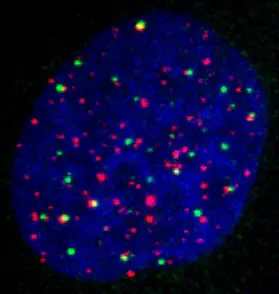The ends of the chromosomes, the telomeres, are repetitive DNA sequences that shorten every time a cell divides during the process of duplicating its genome. Once the telomeres become very short the cell stops dividing. Thus, telomeres work like a cellular clock that keeps an eye on the number of cell divisions. And once the cell’s time is over it can no longer divide. Circumventing this control mechanism is crucial for tumor cells in order to proliferate without limits. In the majority of tumors this is accomplished by reactivating telomerase, an enzyme that normally extends the telomeres only in embryonic cells, and thus resets the cellular clock during development. However, a 10-15% fraction of tumors keeps on dividing without telomerase by making use of what is called the ALT-mechanism for “Alternative Lengthening of Telomeres". The hallmark of ALT cancer cells is a special type of complexes of promyelocytic leukemia (PML) protein at the telomeres that are termed ALT-associated PML nuclear bodies or APBs.
ALT-tumors can be identified by the presence of APBs on fluorescence microscopy images since normal cells do not have these structures. However, the function of APBs has remained mysterious. In a recent study, Inn Chung and Karsten Rippe from the German Cancer Research Center together with Heinrich Leonhard from the LMU in Munich applied a novel approach to study APBs. They succeeded in artificially making APBs in living cells by tethering PML and other APB proteins to the telomeres. In this manner they could not only trace the assembly of APBs but were able to investigate what happens after APB formation. They could show that the de novo formed APBs induced the extension of the telomere repeat sequence by a DNA repair synthesis mechanism. This demonstrates for the first time that APBs have an important function for the alternative telomere lengthening mechanism, and suggests that disrupting APBs would stop proliferation of ALT-positive tumor cells once their telomeres become too short. This makes APBs a promising new target of cancer cells, in which the ALT mechanism is active.
Publication: Chung, I., Leonhardt, H. & Rippe, K. (2011). De novo assembly of a PML nuclear subcompartment occurs through multiple pathways and induces telomere elongation. J. Cell Sci., doi: 10.1242/jcs.084681.



